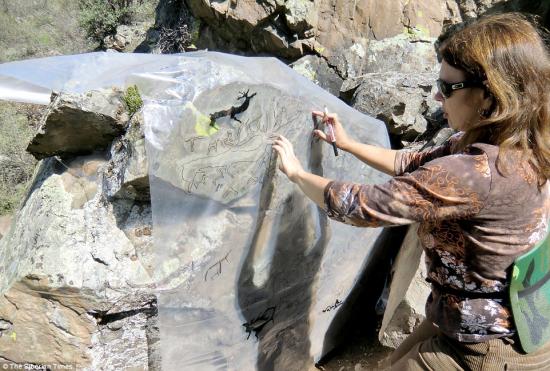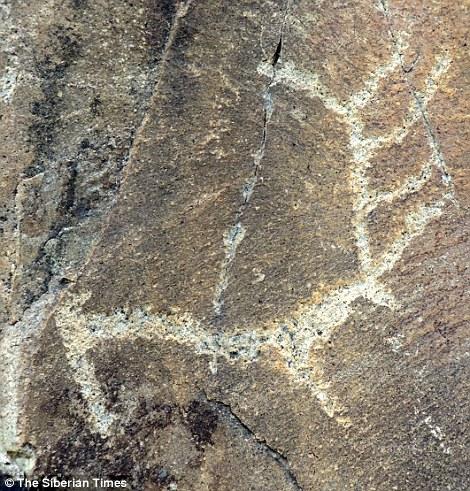Will Stewart
Source - http://www.dailymail.co.uk/travel/travel_news/article-2817720/Archaeologists-encounter-extraordinary-alfresco-gallery-prehistoric-art-stunning-Altai-Mountains-one-great-undiscovered-tourist-destinations-Siberia.html
Archaeologists in Siberia have begun uncovering an extraordinary alfresco gallery of prehistoric art high in the 4,506-metre tall Altai Mountains. While the region is famed for petroglyphs (rock engravings), new finds are being made in the hidden and rarely-visited Saldyar valley, close to the fast-flowing Katun River. Here beneath the densely-wooded slopes they are discovering remarkable rock pictures dating back 5,000 years, close to Russia's border with China and Mongolia.

Archaeologists in Siberia have begun uncovering an extraordinary alfresco gallery of prehistoric art in the mountains
Further searches for this ancient treasure trove will go ahead after the snow melts next year. Professor Andrey Borodovsky, from the Institute of Archaeology and Ethnography at the Siberian branch of the Russian Academy of Sciences, said: 'The total number of petroglyphs in Saldyar is several thousand, both separate images and whole compositions. This area is very rarely visited by researchers. Therefore, we can confidently say that it is one of the few places in the mountains where we're still waiting for sensational discoveries to be made.' Reaching the artwork here is a task in itself, with the area separated from the outside world by the high jagged peaks of the Saldyarskiy pass. Roads in this region are almost non-existent and with no mobile phone signal, nor an modern civilisation close at hand, it can feel extremely isolated - yet this artwork suggest this was a hub of human creativity in millennia gone by. 'It is a place unlike any other and is, arguably, one of the greatest art galleries anywhere in the world. Yet you won't find masterpieces in the traditional sense here, with no Rembrandts, Monets, or Da Vinci's anywhere in sight,' said The Siberian Times.

The artwork suggest this was a hub of human creativity in millennia gone by
The Altai Mountains in southern Siberia are one of the great undiscovered tourist destinations, featuring breathtaking lakes and peaks, with many signs of the ancient lost world, such as burial mounds, standing stones and the exhibition of petroglyphs, many from the Bronze and Iron ages. Many of the carvings are found on rocks that form a symbolic rock garden, with the sun's beams helping to illuminate the artistic work and making them appear similar to photograph negatives. According to Altai legend, the location of these megaliths was a result of the mythical hero Sartaksakpay, who is said to have jokingly changed the direction of the rivers and scattered the mountain valleys with huge rocks. Archaeologists studying the petroglyphs found that the ancient artists had several favourite images, including the Siberian mountain goat, which has always been seen as a symbol of success and good luck as well as being good hunting prey. Another of the most popular images at Saldyar is the long horned bull, a symbol of a bygone era that once roamed in Ancient Egypt, Mycenaean Greece and Central Asia.

Drawings depict deer, shown with strangely disproportionate large sizes of horns and a snout that resembled a bird's beak

Another of the most popular images at Saldyar is the long horned bull, a symbol of a bygone era

Archaeologists are still puzzled as to why the ancient civilisations carved the images in the first place


Drawings dating from the early nomadic era depict deer, shown with strangely disproportionate large sizes of horns and a snout that resembled a bird's beak. What is perhaps most interesting about these depictions is that similar petroglyphs have been found as far afield as Mongolia and Trans-Baikal, showing that even in ancient times certain ideas and styles travelled a considerable distance. Other carvings depict hunters standing beside the beasts with their bows and arrows. Yet archaeologists are still puzzled as to why the ancient civilisations carved the images in the first place. Some say they were drawn as signs of rituals dedicated to the gods or spirits, to help them fatten up their cattle, others believe they are simply depictions of hunting parties. Another theory is that the carvings showed where the best hunting trails lay. The truth is, no one will truly know. Yet, whatever else these pictures show, they highlight the fact that the world's artists were already hard at work many millennia ago.